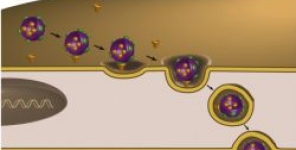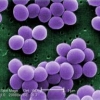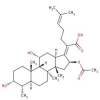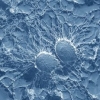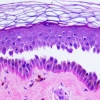L'artesunato potenzia l'attività antibatterica dei β-lattamici aumentando l'accumulo degli antibiotici negli Staphylococcus aureus resistenti alla meticillina (MRSA)
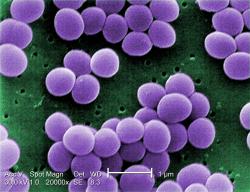 Lo Staphylococcus aureus resistente alla meticillina (MRSA) è ormai emerso come grave e predominante patogeno a causa della sua resistenza ad un ampio gruppo di antibiotici, con conseguente alta morbilità e mortalità. Pertanto, è necessario sviluppare urgentemente nuovi agenti contro la resistenza. In precedenza, è stato scoperto che l'artesunato (AS) aumenta l'effetto antibatterico dei β-lattamici contro MRSA. In questo studio è stato riscontrato mediante la microscopia laser confocale e il metodo della cromatografia liquida in tandem abbinata a MS che, AS aumenta per prima cosa l'accumulo degli antibiotici (daunorubicina e oxacillina) all'interno di MRSA suggerendo che un maggiore accumulo degli antibiotici potrebbe essere correlato al rafforzamento di AS sugli antibiotici stessi. Inoltre, attraverso l'uso di un microscopio elettronico a trasmissione, è stato rilevato che AS non distrugge la struttura cellulare di MRSA; AS inibisce le espressioni geniche di importanti pompe di efflusso come NorA, NorB e NorC, ma non MepA, SepA e MdeA. In conclusione, i nostri risultati hanno dimostrato che AS è in grado di valorizzare l'attività antibatterica dei β-lattamici attraverso un crescente accumulo di antibiotici all'interno degli MRSA, in particolare inibendo le espressioni geniche delle pompe di efflusso come NorA, NorB e NorC, ma senza distruggendo la struttura cellulare di MRSA. AS potrebbe essere ulteriormente studiato come potenziale farmaco per il trattamento delle infezioni da MRSA.
Lo Staphylococcus aureus resistente alla meticillina (MRSA) è ormai emerso come grave e predominante patogeno a causa della sua resistenza ad un ampio gruppo di antibiotici, con conseguente alta morbilità e mortalità. Pertanto, è necessario sviluppare urgentemente nuovi agenti contro la resistenza. In precedenza, è stato scoperto che l'artesunato (AS) aumenta l'effetto antibatterico dei β-lattamici contro MRSA. In questo studio è stato riscontrato mediante la microscopia laser confocale e il metodo della cromatografia liquida in tandem abbinata a MS che, AS aumenta per prima cosa l'accumulo degli antibiotici (daunorubicina e oxacillina) all'interno di MRSA suggerendo che un maggiore accumulo degli antibiotici potrebbe essere correlato al rafforzamento di AS sugli antibiotici stessi. Inoltre, attraverso l'uso di un microscopio elettronico a trasmissione, è stato rilevato che AS non distrugge la struttura cellulare di MRSA; AS inibisce le espressioni geniche di importanti pompe di efflusso come NorA, NorB e NorC, ma non MepA, SepA e MdeA. In conclusione, i nostri risultati hanno dimostrato che AS è in grado di valorizzare l'attività antibatterica dei β-lattamici attraverso un crescente accumulo di antibiotici all'interno degli MRSA, in particolare inibendo le espressioni geniche delle pompe di efflusso come NorA, NorB e NorC, ma senza distruggendo la struttura cellulare di MRSA. AS potrebbe essere ulteriormente studiato come potenziale farmaco per il trattamento delle infezioni da MRSA.
Storia della pubblicazione:
Titolo: Artesunate has its enhancement on antibacterial activity of β-lactams via increasing the antibiotic accumulation within methicillin-resistant Staphylococcus aureus (MRSA).
Rivista: J Antibiot (Tokyo). 2013 Apr 3. doi: 10.1038/ja.2013.22.
Autori: Jiang W, Li B, Zheng X, Liu X, Pan X, Qing R, Cen Y, Zheng J, Zhou H.
Affiliazioni:Department of Pharmacology, College of Pharmacy, The Third Military Medical University, Chongqing, China.
Abstract:
Methicillin-resistant Staphylococcus aureus (MRSA) has now emerged as a predominant and serious pathogen because of its resistance to a large group of antibiotics, leading to high morbidity and mortality. Therefore, to develop new agents against resistance is urgently required. Previously, artesunate (AS) was found to enhance the antibacterial effect of β-lactams against MRSA. In this study, AS was first found to increase the accumulation of antibiotics (daunorubicin and oxacillin) within MRSA by laser confocal microscopy and liquid chromatography-tandem MS method, suggesting the increased antibiotics accumulation might be related to the enhancement of AS on antibiotics. Furthermore, AS was found not to destroy the cell structure of MRSA by transmission electron microscope. AS was found to inhibit gene expressions of important efflux pumps such as NorA, NorB and NorC, but not MepA, SepA and MdeA. In conclusion, our results showed that AS was capable of enhancing the antibacterial activity of β-lactams via increasing antibiotic accumulations within MRSA through inhibiting gene expressions of efflux pumps such as NorA, NorB and NorC, but did not destroy the cell structure of MRSA. AS could be further investigated as a candidate drug for treatment of MRSA infection.
